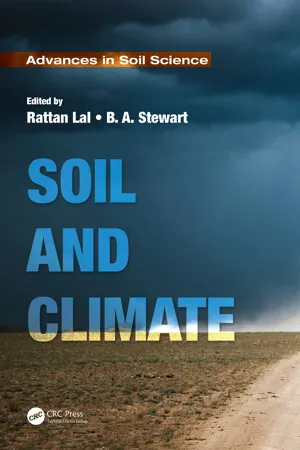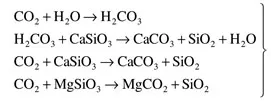
Soil and Climate
Rattan Lal, B. A. Stewart, Rattan Lal, B. A. Stewart
- 434 Seiten
- English
- ePUB (handyfreundlich)
- Über iOS und Android verfügbar
Soil and Climate
Rattan Lal, B. A. Stewart, Rattan Lal, B. A. Stewart
Über dieses Buch
Climate is a soil-forming factor and soil can mitigate climate change through a reduction in the emissions of greenhouse gases and sequestration of atmospheric CO2. Thus, there is a growing interest in soil management practices capable of mitigating climate change and enhancing environmental quality. Soil and Climate addresses global issues through soil management and outlines strategies for advancing Sustainable Development Goals (SDGs).
This volume in the Advances in Soil Science series is specifically devoted to describe state-of-the-knowledge regarding the climate–soil nexus in relation to:
-
- Soil Processes: weathering, decomposition of organic matter, erosion, leaching, salinization, biochemical, transformations, gaseous flux, and elemental cycling,
-
- Soil Properties: physical, chemical, biological, and ecological,
-
- Atmospheric Chemistry: gaseous concentrations of (CO2, CH4, N2O), water vapors, soot, dust, and particulate matter,
-
- Mitigation and Adaptation: source and sink of GHGs (CO2, CH4, N2O), land use and soil management, soil C sink capacity, permafrost,
-
- Soil Management: sequestration of organic and inorganic C, nutrient requirements, water demands, coupled cycling of H2O, N, P, S, and
-
- Policy and Outreach: carbon farming, payments for ecosystem services, COP21, SDGs, land degradation neutrality
Special topics on soil as a source or sink of CO2, silicate weathering and carbon sequestration, nutrients required for carbon sequestration, physical protection and the mean resident time, and predicting soil carbon stocks are discussed in detail throughout the book.
Häufig gestellte Fragen
Information
1Soil and Climate
1.1Climate–Soil Interaction
1.2Soil Life and the Atmosphere

Inhaltsverzeichnis
- Cover
- Half Title Page
- Series Page
- Title Page
- Copyright Page
- Contents
- Preface
- Editors
- Contributors
- Chapter 1 Soil and Climate
- Chapter 2 Soil—The Hidden Part of ClimateMicrobial Processes Regulating Soil–Atmosphere Exchange of Greenhouse Gases
- Chapter 3 Regionally Diverse Land-Use Driven Feedbacks from Soils to the Climate System
- Chapter 4 Conservation AgricultureMaintaining Land Productivity and Health by Managing Carbon Flows
- Chapter 5 Nutrient Requirements for Soil Carbon Sequestration
- Chapter 6 Physical Protection and Mean Residence Time of Soil Carbon
- Chapter 7 Nitrogen Cycling and Dynamics in Terrestrial Ecosystems
- Chapter 8 Biochar for Climate Change MitigationNavigating from Science to Evidence-Based Policy
- Chapter 9 Silicate Weathering to Mitigate Climate Change
- Chapter 10 Determination of Secondary Carbonates
- Chapter 11 Effects of Plant Invasions on the Soil Carbon Storage in the Light of Climate Change
- Chapter 12 Climate Change Impact on Soil Carbon Stocks in India
- Chapter 13 Soil Degradation and Climate Change in South Asia
- Chapter 14 The Soil–Livestock–Climate Nexus
- Chapter 15 Soil and Human Health in a Changing Climate
- Chapter 16 Climate Change and the Global Soil Carbon Stocks
- Index


